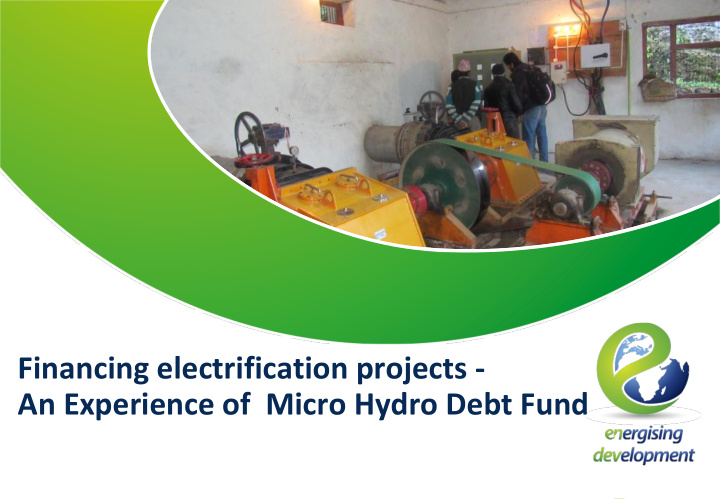



Financing electrification projects - An Experience of Micro Hydro Debt Fund
Content of Presentation 1. Introduction of Energising Developing (EnDev) 2. EnDev support to MHDF 3. RE Financing: Limits and Challenges 4. Opportunity in RE Financing 2
Energising Development • Energising Development (EnDev) is a partnership for energy access currently financed by seven donor countries. • As of December 2015, EnDev works in 26 countries in Africa, Asia and Latin America. • Since 2005, EnDev has taken a leading role in facilitating access to sustainable energy and has reached 14.8 million people to date. 3
Technology intervention of EnDev globally Technology intervention in Nepal 4
EnDev intervention in MHP development − Financial Assistance initial investment costs (through Micro Hydro Debt Fund) • − Technical Assistance • Capacity Building of Banks • Capacity Building of AEPC • Field visit support 5
Rationale of Debt Fund • A fund gap of approx. 30% • High perceived risk due to insufficient experiences in dealing with renewable energy projects and lending to rural areas. Consequently, many viable MHP projects are not implemented. • Banks can use this experience to lend extensively, using their own funds 6
Approach
Main Features • Capacity building and financial education • Risk sharing is 50/50 between the fund/AEPC and the banks • Project Finance basis, so no collateral • Risk mitigation through Insurance coverage • MHPs eligible for subsidy, selection based on Bank’s due diligence, • Maximum 12% interest rate • Tenure typically 5-8 years 8
MHPs through MHDF on map 9
Status • typically 20-30% credit financed • 10-100kW projects that received GoN/AEPC subsidy • 1,005 kW of installed capacity • 15171 individuals benefit, 5461 households benefit • 42 social infrastructures • 42 productive end uses 10
Achievement • MHDF provided initial capital for gaining first experience for the banking sector to estimate risks • Private sector involvement increased filling the gap on energy access sector • Improved access to credit for rural electrification • Establishment of CREF, also due to proof of concept by EnDev • Risk covered by insurance functioned well 11
Voice from the Field • Mr. Bed Bahadur Gurung, Chairman of Arkhet Khola tells his story how this fund helped them to come over funding gap. They were very happy when they could electrify the village. However, the challenge is about repayment. And he thinks HH number really plays an important role here. And now with earthquake, they are in difficult situation. 12
Challenges of the Credit Financing • Low outreach of financial services/intermediaries • Offering affordable interest rate • Small businesses which have poor economies of scale • Change in subsidy resources • Fees collected for repaying loan are often diverted to more pressing issues • After sales service not satisfactory and not enforced as well • Comply with federal structure 13
Making it Work better • Value chain financing (Tying with PEU components) and capacity building of communities • Strengthen the Monitoring mechanism of banks, use of decentralized services • Framework conditions – feed in tariff (ensures revenue stream to banks) • Use of bank’s expertise or civil society to advise community to make informed decisions • Innovations at Insurance space 14
Thank you for your attention. Funded by: Coordinated by: 15
Contact: Pooja Sharma pooja.sharma@giz.de www.endev.info/content/Nepal
Recommend
More recommend